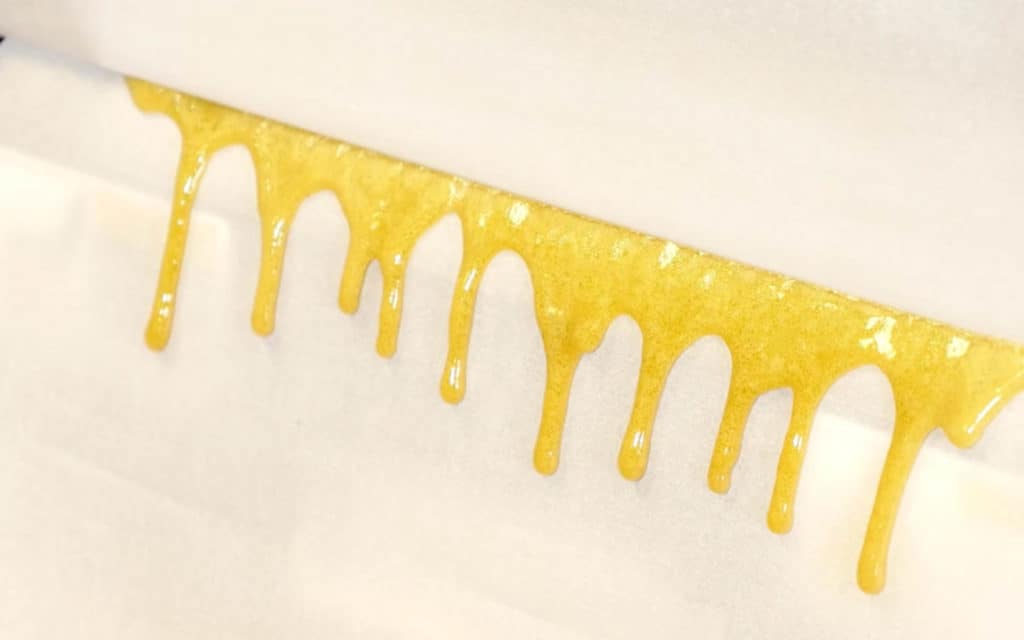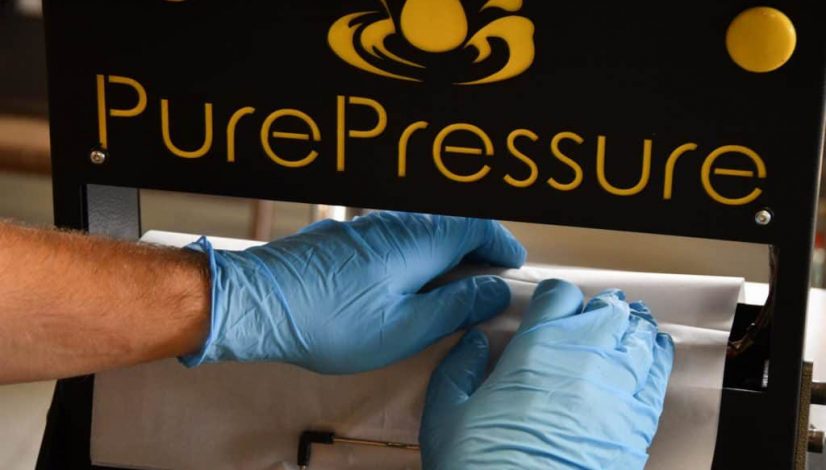Why The Rosin Revolution Is Real
This post is sponsored by Pure Pressure.
More often than not, the word “revolution” is used hyperbolically—i.e. very few things are legitimately revolutionary. Rosin extraction is an exception to the common misuse of this very powerful word.
The entire cannabis industry should take note: Rosin’s revolution is underway and will profoundly impact patients, consumers and businesses. Now emerging from relative obscurity in a concentrate market dominated by BHO, rosin is no longer confined to the realm of hobbyist’s hair straighteners and repurposed shop presses.
With the evolution in rosin press technology, rosin can now be produced on a commercial scale cheaply and safely. It comes as no surprise to many that concentrated cannabis products, such as shatter, wax, pre-filled vape pens and related extracts are in incredible demand across the country. For example, Colorado saw a surge of over 125 percent growth in concentrate sales between Q1 of 2015 and 2016, which is likely to be replicated in other maturing markets.
Patients and consumers alike are finding out that concentrates typically act as very potent medicines and offer unparalleled relief, flavors and experiences. On top of all of this momentum, rosin is uniquely poised to become product of choice and preferred extraction method by many.
The bottom line is that rosin is the cheapest, safest and easiest way to create full melt, dab-friendly cannabis concentrates.
Demand for Rosin Will Increase Exponentially
Rosin is on track to become one of the connoisseur’s primary concentrates of choice and a big part of the extraction product mix of nearly every cannabis business operation for the following reasons:
- Rosin is 100 percent free of solvents, so it is certain that health conscious consumers will seek it out, perhaps exclusively. Additionally, contaminants and pesticides aren’t removed in the rosin extraction process, so product testing yields transparent source-material results, further increasing rosin’s potential value.
- Rosin is just as potent as BHO and other concentrates by cannabinoid percentage, typically in the 70 percent range, but has also been known to test in the high 80 percentage range and beyond.
- Rosin extraction is extremely safe with absolutely no risk of explosion, ignition or serious bodily harm that are possible with flammable solvents.
- Rosin is significantly cheaper to produce compared to solvent-based extraction methods, often with comparable yields. The startup costs required for extracting rosin are dramatically less than any solvent-based, closed-loop system.
- Rosin is often extracted from premium quality material, not questionable bulk trim. Terpene preservation in rosin is also very high, and some rosin has been tested at nearly 13 percent total terpene content or more.
- Rosin can be manipulated into nearly all popular textures or consistencies, such as shatter, wax, crumble, budder, sugar, etc., so that virtually anyone can enjoy their favorite type of concentrate free of solvents.
- Rosin can be made profitably from virtually any starting material available, including dry sift, flowers, bubble hash or sifted trim, and typically retails anywhere from $40 – $80 per gram recreationally.
If that isn’t enough to convince you that rosin has massive potential, read on.
Simply put, rosin is extremely safe to extract and multitudes cheaper to produce than other competing methods. For these reasons, it’s immediately clear that rosin will have a very prominent place in the burgeoning cannabis industry.

Safety Is Key
In doing away with butane, propane, alcohol, CO2 and other solvent-based methods, rosin is easily one of the safest ways to produce highly desirable cannabis concentrates. There is never a risk of explosion or dangerous ignition, which is hugely important. This means that rosin extraction provides a few critical benefits.
First and foremost, extracting rosin never puts a lab technician or extractor in harms way. Secondly, the amount of ancillary equipment required to handle the extraction process itself is negligible, so that the ventilation and storage of dangerous solvents is no longer part of the equation. Safety is a crucial aspect of cannabis extraction that regulators are demanding given the news stories that have circulated about amateurs blowing themselves and their homes apart.
On the opposite end of the spectrum, the caregiver and medicinal at-home extraction market is expanding rapidly right alongside licensed laboratories, which resembles in many ways the wildly popular craft brewing scene. At the time of writing, anyone can buy closed-loop extraction systems generally with or without proper licensure, and the same goes for rosin presses.
Producing rosin is the only truly viable and safe extraction method alongside hash washing, especially so in a non-laboratory setting. The safety of extracting rosin massively benefits caregivers and patients alike so that they can create their own concentrates without risking life and limb or a felony.

Rosin Is Inexpensive to Make
Many people tend to think that rosin will simply remain a cottage industry, one carried out only on a very small scale. Rosin extraction technology is developing at light speed, and now many businesses, such as the current industry leader PurePressure, are offering commercial-scale rosin presses that have outputs comparable to small and medium sized closed-loop extraction systems that cost around 10 times less.
That is not a typo.
For example, the Pikes Peak rosin press costs under $6,000 and can process four pounds or more of flower per day or easily double that amount of dry sift or hash, with a single operator in one day. This amount of material processed per day is similar to a smaller closed-loop extraction systems, which run between $40,000 – $80,000 or more by themselves. The price difference is especially staggering when every factor necessary to run a solvent-based extraction unit is taken into account.
When weighing the costs of rosin production against virtually any other extraction method, it becomes clear why rosin is going to revolutionize cannabis.
If you add up all of the costs of closed-loop extraction, it quickly becomes apparent how expensive it really is. Here is a list of what is necessary to get a closed-loop system operational:
- The solvent-based extraction machine itself
- Recirculators, pumps, vacuum purge ovens and other ancillary equipment
- Specialized HVAC requirements
- Significant laboratory square footage
- Extra construction and blast-proof building requirements
- Expert lead extraction artists and technicians that command hefty salaries
- Massive investment of time before anything is being extracted at all
Add all of that up and a typical business is looking at hundreds of thousands of dollars on the low end just to get started with BHO or CO2 extraction.
Producing rosin, on the other hand, does away with pretty much all of these extra costs.
All you need to get going with rosin is a press, often with an air compressor and the inexpensive accessories necessary to collect the rosin itself. Since rosin extraction is fundamentally simple, the labor costs involved are also quite a bit lessened. This is not to take anything away from the skill and expertise of professional extractors whatsoever, but it goes to show that methodologies for extracting rosin can be successfully executed and learned by employees with less experience.
Basic rosin extraction set up: $3,000 – $10,000
Basic closed-loop extraction set up: $100,000 – $200,000, often more
Another huge benefit with rosin, especially for new labs and caregivers, is that you can get started with rosin and produce incredible concentrates same-day. Conversely, closed-loop systems typically require months of planning to execute and begin processing. When it comes to the bang for your buck, as well as your time, producing rosin is a no-brainer for anyone interested in producing concentrates.

Conclusion
Rosin technology and extraction methods are certain to be ubiquitous in the cannabis industry going forward.
Regulators and politicians across the United States are keeping close tabs on existing cannabis state markets, so without a doubt solvent-less extraction methods are viewed favorably when compared to BHO and other highly flammable alternatives.
Recently legalized states, both medical and recreational, are formulating new laws to regulate cannabis cultivation, processing, distribution and sales. Safety will be a carefully considered element by these lawmakers, and rosin extraction fits comfortably into framework that satisfies legislators and fire departments alike.
When you consider the natural progression of technology toward automation, rosin is well on its way to compete output-wise with massive scale solvent-based extraction systems.
According to ArcView, the cannabis industry is already worth a whopping $6.7 billion, with expectations to grow to over $20 billion by 2021. We can only speculate how the concentrates market will concurrently grow nationally, but if Colorado, the country’s most mature recreational market, is any indication, it’s almost certain to grow dramatically across the country.
It is easy to envision a future where rosin presses are commonplace in all dispensaries, so that customers can simply purchase flower and press it on the spot into dabs.
All aspects considered—from safety, to cost, to ease of use—rosin is a clear frontrunner for being the most widely practiced method of extraction.
The general consensus is growing strongly in favor of a true rosin revolution. We strongly believe that this new wave of solvent-less concentrate production will empower patients and growers, as well as businesses ,big and small.
There’s no telling exactly what will happen in the next few years as the cannabis industry evolves, but you can be sure that rosin will be a big part of it.
Follow PurePressure on Social Media
YouTube: Pure Pressure
Facebook: /GoPurePressure
Instagram: @GoPurePressure
MassRoots: @GoPurepressure
Related: What Do The Labs Have To Say About Rosin-Tech?


